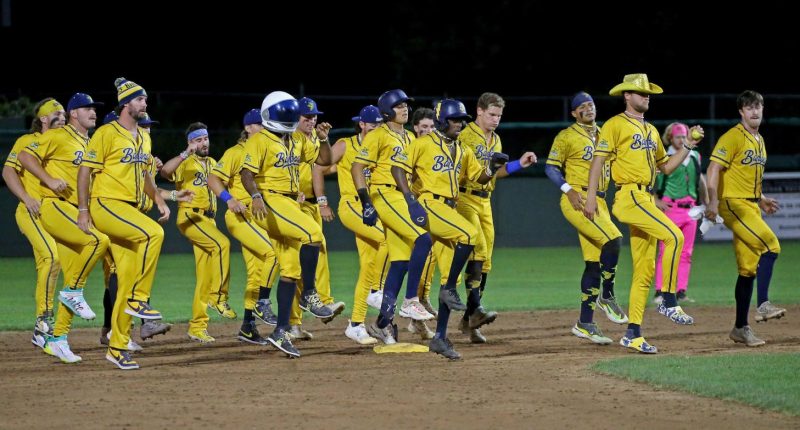Share this @internewscast.com
In order to play for the Savannah Bananas, you need to be able to cut loose and cut a rug. (Staff … More
MediaNews Group via Getty Images
*This is the second in a multi-part series on the Savannah Bananas.
The Savannah Bananas are a lot of things: a traveling circus; a close-knit group of players, performers, team members (not “employees”); a family affair; and the best night you will have at the ballpark all year (non-October division). What they are most decidedly not: a way-station for ballplayers trying to find their way back to organized baseball.
The Bananas are a social media phenomenon. There is a multi-part documentary on ESPN; reports on 60 Minutes; and a YouTube series, “Bananaland: The Road To Cooperstown.” Not to mention that they maintain an active presence on TikTok. But while watching at home is interesting, the Savannah Bananas need to be seen in person to be truly experienced.
If you are unfamiliar with the team and their story, my colleague here at Forbes.com, Candace Oehler wrote a great piece about the team and their owners, Jesse and Emily Cole.
But when this writer visited the team in Arizona, I wanted to learn a little bit about the stars of the show: the players. Research showed that a great many hail from the minors or independent baseball. The team actually started in 2016 in the Coastal Plains League, which is a summer collegiate league, so the first batch of players came from that cohort. But what about today?
As a quick review, the Bananas are made up of roughly 25 players. And they play against the Party Animals, the Firefighters, the Visitors, and the Texas Tailgaters. While at first blush it would seem that each opponent is the baseball equivalent of the Washington Generals (with the Bananas serving as the Harlem Globetrotters), that could not be further from the truth. As Jesse Cole told me, there are two ways in which Banana Ball is different than the nearly 100-year old basketball traveling roadshow: (1) The Bananas put on a different show every night (at least 15 different routines each game); and (2) There is real competition on the field. The outcome of each Bananas game is not pre-ordained; the players on both sides are out there to perform, and to win.
Because of that, I wondered if the players were putting their best foot forward every time with the hope of catching (back) on with a team in organized baseball. But in interviews with more than a dozen players across multiple teams, only one even considered the possibility. One pitcher (who shall remain nameless to protect his anonymity), cut by two different professional organizations, said he would at least answer the phone if a professional club were to call; but he doubted he would take the offer if one came. He was having too much with this group.
Jesse, and his wife, Emily, run the Bananas as a team, as a business, and as a family. And, to that end, they work overtime to make sure everyone is taken care – financially as well as emotionally. Unlike professional baseball (including the major leagues), the Bananas work on year-round contracts. That means everyone in the organization – most specifically, the players – are guaranteed income for twelve months, not just six or seven as is the case in other professional ranks.
The players are well-renumerated. While no one – not the players nor the owners – would divulge what each gets paid, it was intimated that the players make considerably more than typical minor league salaries (even taking into consideration the new minor league collective bargaining agreement that was introduced in 2023), but well below big league money. It is, without question, a living wage. Further, each player has full health benefits.
As in organized baseball, all contracts are individualized based on what the player brings to the table. Baseball skills, fans-first focus, ability to create unforgettable moments, level of fan engagement – both on and off the field, including on social media – are all components of what a player may get paid. Social media, in fact, is a massive part of the equation. The Bananas have more than 10 million followers on TikTok (up from 8.4 million this time last year), nearly three million on Instagram (up more than 10% since last year), but a mere 216,000 on X, formerly Twitter (which may say something about the age of their followers). With so much of their fan engagement done via the socials, the club is always looking for players who have – or can create – a huge following. Currently, infielder Jackson Olson is the leader by a mile, with 1.9 million followers on TikTok. But many of his teammates clock in with hundreds of thousands of followers, including Alex Ziegler, who has about 630,000, and was discovered by the club doing his bat tricks on social media. The Bananas want their players “out there” hyping the game, the team, and the whole Banana ethos.
Jesse and Emily operate with the mantra: “Fans First. Entertain Always.” So, when the Bananas first formed to be the team(s) they would become, the vetting process for players was thorough, but tricky. Would a collegiate or former professional baseball player be willing to rip off his shirt and stand topless in the batter’s box?
Savannah Bananas Drew Yniesta goes topless as he comes to bat. (Photo by Stan Grossfeld/The Boston … More
Boston Globe via Getty Images
How would he feel about twerking his way from the on-deck circle to the plate? Could he break out into dance on the mound, and then make a competitive pitch? What would these players do to give the fans the time of their life?
At first, Jesse and Emily and their staff had to work extremely hard, looking all over the world to find the right balance of players who had the skills – both baseball and entertainment – to be part of this group. Now, with the organization’s global success, they receive “thousands” of submissions each day that they have to cull to see who will make a good member of any of their teams. While the pool of potential players has gotten larger, choosing the right players has not gotten easier. At the end of the day, the Coles want to make sure they have a competitive game and an unparalleled show.
The competitive aspect is what I was dubious about. How could a guy who does a backflip while catching a flyball really care about winning? How does a team truly set up to play defense behind a pitcher standing nearly 11-feet tall wearing stilts?
Dakota “Stilts” Albritton stands nearly 11-feet tall before he gets on the mound. (Photo by Al … More
Getty Images
Would a player who could steal first base on a wild pitch really take the game seriously? Would players really chase a ball from the pitcher’s mound to the warning track to keep a runner from scoring in what we would call “extra innings” but they call a “showdown?” The answer to each question is: MOST CERTAINLY!
The competition is very much real. Pitchers are trying to strike out batters; batters are swinging for the fences; runners are trying to take the extra base; and fielders are trying to get outs – even if they add a whole lot of flair to the process.
In the concourse after a game in Mesa, Arizona, one Banana player told me that he was happy they had won that night, as they had now won the series, which took a little pressure off of the next day’s game. Another remarked that last season’s seven-game losing streak to the Firefighters still stuck in his craw.
When a Banana hit a hard shot into hole at short, he busted down the line, and was none-too-pleased when the throw beat him by half a step. You could see the player’s frustration from the press box. Just because he was wearing a bright yellow uniform and the game had a clock and the first base coach was breakdancing, doesn’t mean that the competitive zeal with which he has played the game his entire life went away. But, within seconds of heading back to the dugout, the frown was gone, and his smile was back. There was no thrown helmet or pouting on the bench. In fact, by the time he was back among his teammates, he was once again part of the party. But while in the batter’s box and while running down that line, his fire burned just as hot as if there were twenty scouts in the stands judging his every movement.
[It should be noted that no one actually sits in the dugout. Every coach and player is in front of the dugout enjoying the party as much as the fans in the stands.]
Jesse and Emily have grand plans to grow their game. This summer they will be in 40 cities covering 28 states plus Washington, D.C. They currently have five teams, and are looking to add a sixth. The resumes and videos keep pouring in. There is no longer a dearth of players to choose from. But, as they have from day one, they will be persnickety and exacting, discovering players that are “genuinely positive, happy, and outgoing…who understand that you know our job is to bring joy.” Never resting on their laurels, they continue to be on the hunt for the perfect bunch of Bananas.








